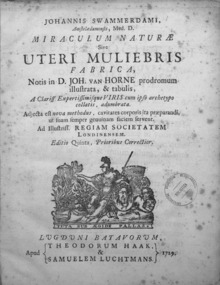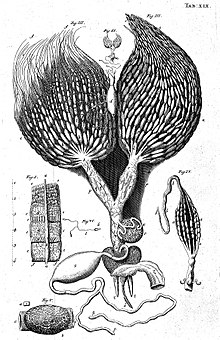Jan Swammerdam
Jan Swammerdam | |
|---|---|
erythrocytes, work on entomology | |
| Scientific career | |
| Fields | Entomology |
Jan or Johannes Swammerdam (February 12, 1637 – February 17, 1680) was a Dutch biologist and microscopist. His work on
Education

Johannes Swammerdam was baptized on 15 February 1637 in the
As a youngster, Swammerdam had helped his father to take care of his
In 1663 Swammerdam moved to France to continue his studies. It seems together with Steno.
Together with van Horne, he researched the anatomy of the uterus. The result of this research was published under the title Miraculum naturae sive uteri muliebris fabrica in 1672. Swammerdam accused Reinier de Graaf of taking credit of discoveries he and Van Horne had made earlier regarding the importance of the ovary and its eggs. He used waxen injection techniques and a single-lens microscope made by Johannes Hudde.
Research into insects
While studying medicine Swammerdam had started to dissect insects and after qualifying as a doctor, he focused on them. His father pressured him to earn a living, but Swammerdam persevered and in late 1669 published Historia insectorum generalis ofte Algemeene verhandeling van de bloedeloose dierkens (The General History of Insects, or General Treatise on little Bloodless Animals). The treatise summarised his study of insects he had collected in France and around Amsterdam. He countered the prevailing Aristotelian notion that insects were imperfect animals that lacked internal anatomy.[3] Following the publication his father withdrew all financial support.[5] As a result, Swammerdam was forced, at least occasionally, to practice medicine in order to finance his own research. He obtained leave at Amsterdam to dissect the bodies of those who died in the hospital.[6]

At university Swammerdam engaged deeply in the religious and philosophical ideas of his time. He categorically opposed the ideas behind spontaneous generation, which held that God had created some creatures, but not insects. Swammerdam argued that this would blasphemously imply that parts of the universe were excluded from God's will. In his scientific study, Swammerdam tried to prove that God's creation happened time after time, and that it was uniform and stable. Swammerdam was much influenced by René Descartes, whose natural philosophy had been widely adopted by Dutch intellectuals. In Discours de la Methode Descartes had argued that nature was orderly and obeyed fixed laws, thus nature could be explained rationally.[7]
Swammerdam was convinced that the creation, or generation, of all creatures obeyed the same laws. Having studied the reproductive organs of men and women at university he set out to study the generation of insects. He had devoted himself to studying insects after discovering that the king
When Swammerdam published The General History of Insects, or General Treatise on little Bloodless Animals later that year he not only did away with the idea that insects lacked internal anatomy but also attacked the Christian notion that insects originated from spontaneous generation and that their life cycle was a metamorphosis.[9] Swammerdam maintained that all insects originated from eggs and their limbs grew and developed slowly. Thus there was no distinction between insects and so-called higher animals. Swammerdam declared war on "vulgar errors" and the symbolic interpretation of insects was, in his mind, incompatible with the power of God, the almighty architect.[10] Swammerdam, therefore, dispelled the seventeenth-century notion of metamorphosis —the idea that different life stages of an insect (e.g. caterpillar and butterfly) represent different individuals[11] or a sudden change from one type of animal to another.[12]

Spirituality
Swammerdam suffered a crisis of conscience; his father repudiated the study of insects. Having believed that his scientific research was a tribute to the Creator, he started to fear that he may be worshipping the
Bybel der natuure

His religious crisis only interrupted his scientific research briefly and until his premature death aged 43, he worked on what was to become his main work. It remained unpublished when he died in 1680 and was published as Bybel der natuure posthumously in 1737 by the Leiden University professor
Herewith I offer you the Omnipotent Finger of God in the anatomy of a louse: wherein you will find miracle heaped on miracle and see the wisdom of God clearly manifested in a minute point.[7]
Research on bees

Since ancient times it had been asserted that the queen bee was male, and ruled the hive. In 1586 Luis Mendez de Torres had first published the finding that the hive was ruled by a female, but Torres had maintained that she produced all other bees in the colony through a "seed". In 1609 Charles Butler had recorded the sex of drones as male, but he wrongly believed that they mated with worker bees. In Biblia naturae the first visual proof was published that his contemporaries had mistakenly identified the queen bee as male.[17] Swammerdam also provided evidence that the queen bee is the sole mother of the colony.[18]
Swammerdam had engaged in five intense years of
Research on muscles

In Biblia naturae Swammerdam's research on muscles was published. Swammerdam played a key role in the debunking of the
Swammerdam's research had been referenced before its publication by Nicolas Steno, who had visited Swammerdam in Amsterdam. Swammerdam's research concluded after Steno had published the second edition of Elements of Myology in 1669, which is referenced in Biblia naturae.[22] A letter from Steno to Malpighi from 1675 suggests that Swammerdam's findings on muscle contraction had caused his crisis of consciousness. Steno sent Malpighi the drawings Swammerdam had done of the experiments, saying "when he had written a treatise on this matter he destroyed it and he has only preserved these figures. He is seeking God, but not yet in the Church of God."[23]
Legacy


Together with his father he collected 6,000 objects in 27 drawer cabinets. Swammerdam's Historia insectorum generalis was widely known and applauded before he died. Two years after his death in 1680 it was translated into French and in 1685 it was translated into Latin.
No authentic portrait of Jan Swammerdam is extant nowadays.[24] The portrait shown in the header is derived from the painting The Anatomy Lesson of Dr Tulp by Rembrandt and represents the leading Amsterdam physician Hartman Hartmanzoon (1591–1659).
Notes
- ^ "Jan Jacobsz. Swammerdam". Archived from the original on 2023-05-19. Retrieved 2023-05-19.
- ^ Scheltema, Pieter (1863). Aemstel's oudheid of gedenkwaardigheden van Amsterdam (in Dutch). Scheltema. pp. 103–107.
- ^ ISBN 9789004100060.
- ^ "Het 'Boeck der Natuere' (2006) by Eric Jorink, p. 231". Archived from the original on 2023-05-20. Retrieved 2023-05-20.
- ^ ISBN 9789004100060.
- ^ The American Cyclopædia.
- ^ ISBN 9789047422365.
- ^ "Het 'Boeck der Natuere' (2006) by Eric Jorink". Archived from the original on 2023-05-20. Retrieved 2023-05-20.
- ISBN 9789047422365.
- ISBN 9789047422365.
- ^ "...whereas modern biologists speak of the grub, the pupa and the adult as stages in the life cycle of one individual butterfly, Harvey and his contemporaries always regarded the grub as one individual and the butterfly as another."Elizabeth B. Gasking (1966). Investigations Into Generation 1651–1828. Baltimore: The Johns Hopkins University Press. page 30
- ISBN 1-59691-036-4.
- ^ ISBN 9789047422365.
- ^ Swammerdam, Jan. 1737-1758. Bybel der natuure Archived 2020-12-09 at the Wayback Machine. Amsteldammer. Of Historie der insecten
- ISBN 9789004100060.
- ISBN 9789047422365.
- ISBN 9780226020860.
- ^ ISBN 9780415924672.
- ISBN 9780226020860.
- ISBN 9780415924672.
- ^ a b c d e f g
Cobb M (2002). "Timeline: Exorcizing the animal spirits: Jan Swammerdam on nerve function" (PDF). Nature Reviews Neuroscience. 3 (5): 395–400. S2CID 5259824. Archived from the original(PDF) on 2005-05-15.
- ISBN 9780871698414.
- ISBN 9780871698414.
- ^ "Jan Swammerdam's "portrait"". Archived from the original on 22 October 2013. Retrieved 22 January 2013.
Works
- Bybel der Natuure (in German). Utrecht: Otto de Vries. 1693.
References
- Cobb M. 2002. Exorcizing the animal spirits: John Swammerdam on nerve function. Nature Reviews, Volume 3, Pages 395–400.
- Winsor, Mary P. "Swammerdam, Jan." Dictionary of Scientific Biography. 1976
- Cobb, Matthew. "Reading and writing The Book of Nature: Jan Swammerdam (1637–1680)." Endeavour. Vol. 24(3). 2000.
- O'Connell, Sanjida. "A silk road to biology." The Times. May 27, 2002.
- Hall, Rupert A. From Galileo to Newton 1630–1720R. &R. Clark, Ltd., Edinburgh: 1963.
Further reading
- Jorink, Eric. "'Outside God there is Nothing': Swammerdam, Spinoza, and the Janus-Face of the Early Dutch Enlightenment." The Early Enlightenment in the Dutch Republic, 1650–1750: Selected Papers of a Conference, Held at the Herzog August Bibliothek Wolfenbüttel, 22–23 March 2001. Ed. Wiep Van Bunge. Leiden, The Netherlands: Brill Academic Publishers, 2003. 81–108.
- Fearing, Franklin. "Jan Swammerdam: A Study in the History of Comparative and Physiological Psychology of the 17th Century." The American Journal of Psychology 41.3 (1929): 442–455
- Ruestow, Edward G. The Microscope in the Dutch Republic: The Shaping of Discovery. New York: Cambridge University Press, 1996.
- Ruestow, Edward G. "Piety and the defense of natural order: Swammerdam on generation." Religion Science and Worldview: Essays in Honor of Richard S. Westfall. Eds. Margaret Osler and Paul Lawrence Farber. New York: Cambridge University Press, 1985. 217–241.
External links
- . Encyclopædia Britannica. Vol. XXII (9th ed.). 1887.
- Site devoted to Swammerdam
- Short biography from a website that chronicles the "rocky road to modern paleontology and biology"
- Biography written by Matthew Cobb, a professor at Laboratoire d'Ecologie in Paris
- An English Edition of Swammerdam's "The Book of Nature, or, The History of Insects" From the History of Science Digital Collection: Utah State University
- Works by Jan Swammerdam at Project Gutenberg
- Works by or about Jan Swammerdam at Internet Archive
- Works by Jan Swammerdam at Open Library
- The Correspondence of Jan Swammerdam in EMLO

